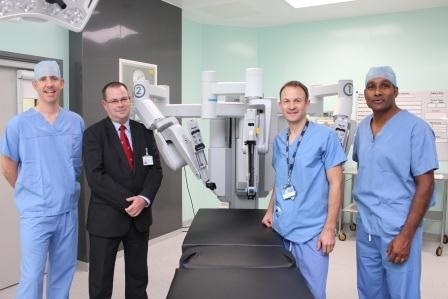Feb 1 2017
More than 1,000 patients at Sheffield Teaching Hospitals have now benefitted from a high-tech robot that enables surgeons to perform highly precise and minimally-invasive surgery.

Surgeons (l-r) Jim Catto, Alan Gillespie, David Yates and Derek Rosario with the Da Vinci robot
The 1,000th operation using the £1.8m Da Vinci machine since it was purchased in 2013 took place on Robert Godley, 57, of Frecheville, Sheffield, who underwent a robot-assisted radical prostatectomy (RARP) performed by Consultant Urologist Mr David Yates.
A radical prostatectomy - the removal of all of the prostate gland to treat prostate cancer – is the procedure most commonly performed using the robot.
Mr Godley said:
I know that this operation has given me the best possible chance of recovery, and I am extremely grateful that the technology is available at the Royal Hallamshire Hospital. I am also very grateful to the staff, not just for their skill but also their care.
A friend of mine was one of the first people to be operated on by Mr Yates using the robot, and he is doing well three years down the line so it was good to have that insight before my own surgery.
Mr Godley is now hoping to be able to return to work as a gardener.
He said:
The diagnosis did come as a bolt out of the blue, but I feel very privileged to have this treatment available on the doorstep. I know people come here from further afield to get the best treatment.
I am so grateful for the speed of treatment I received, because every day counted with the stage of cancer I was at, and there has been good support all the way through.
My wounds have healed quite quickly, with it being small incisions, and I am still able to do everything that I used to be able to.
The Da Vinci has multi-speciality use including Urology, Gynaecology, Colorectal surgery and Ear, Nose and Throat (ENT).
As well as prostatectomies, it is used for procedures including nephrectomies (removal of all or part of the kidney), hysterectomies, bowel cancer operations and tonsil surgery and radical cystectomies (removal of the bladder to treat bladder cancer).
Procedures such as prostatectomies used to be performed by open surgery and laparoscopic (keyhole) surgery, but the robot allows surgeons to perform delicate, complex and less invasive surgery from a sophisticated robotic platform. The surgeon uses joysticks and foot pedals to work the robotic arms from a console, where they can use their eyes, hands and feet to control a 3D HD camera and specialised instruments attached to the arms. The camera is ten times more accurate than the human eye and using specially designed ‘wristed’ instruments, the surgeon can perform complex surgery through small incisions with precision, as the machine adjusts itself to compensate for the natural tremor in the human hand.
The first patient to be operated on using the machine at the Royal Hallamshire was Trevor Risley, 66, of Rotherham. He also underwent a radical prostatectomy.
He said:
It didn’t faze me being the first person. I think progress is a fantastic thing. The surgery went smashing, everything was first class and I was out the following afternoon.
Everything is normal now. I used to be a keen footballer in my younger days and I’ve been able to go back to doing some refereeing.
Mr Yates said:
There are a number of benefits to using the robot – patients only stay in for one night as opposed to three or four for open surgery. There is much less blood loss, so no need for transfusions, and the patients can get back to normal activity more quickly as the robot approach is much less invasive than conventional open surgery.
Functional results, such as urinary incontinence, are improved with the robot and surgeons are not at risk of back and shoulder problems. The 3D view with the articulated instruments also enables you to see lots of detail and be very precise.